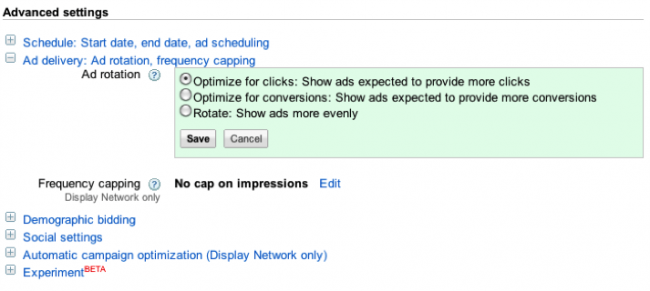Changes to the Google AdWords Pay Per Click Ad Rotation Feature
by Admin
19 Jun
by Darlene Moore
by Darlene Moore
What is Ad Rotation?
Currently AdWords offers three different variations for ad rotation:
- Optimize for clicks (default): The default setting if an Ad Group has two or more ads running. Ads which are expected to provide more clicks are served up often compared to other ads in the ad group, resulting in this ad achieving a greater number of impressions from which it can potentially obtain clicks.
- Optimize for conversions: Ads which are expected to provide more conversions are served up more frequently compared to other ads in the ad group. If there is not enough conversion data to determine which ad will provide the most conversions, ads will rotate using “Optimize for clicks” data.
- Rotate evenly: Each ad in the Ad Group will receive approximately the same “air play time” or receive the same number of impressions. This setting creates a controlled test environment and allows determination of which ads are performing the best as measured by either CTR.

What Has Changed?
In May, Google AdWords announced “all ads that are older than 30 days will auto-optimize to the most clickable ad rotation behavior. Otherwise, it will be 30 days from the day the new creatives for ad rotation were added.”
Instead of rotating creatives for an indefinite period of time, this setting will only rotate for a period of 30 days. After that, the setting will then optimize to show the ads expected to generate the most clicks. Every time a creative is enabled or edited, the ads in that ad group will rotate more evenly for a new period of 30 days.
This feature essentially sets a 30 day time limit for all ads that are using the “Rotation” setting; after those 30 days, settings will automatically be set to optimize for clicks. Furthermore, a campaign’s ‘Ad rotation’ setting will continue to say ‘Rotate evenly’ after the even rotation period has ended.
This new change makes it impossible to do long tail or small account testing as 30 days often is not enough time for two ads to generate sufficient impressions to make the CTR or Conversion Rate data reliable.
For an advertiser, performance is usually based on Conversions/Leads, not clicks. This new change will place the emphasis on ads that receive the highest number of clicks, not CTR or Conversion Rate and may result in additional costs for some advertisers.
What Can You Do?
My first thought was to make a change to at least one ad within the Ad Group every 30 days to maintain the “rotate evenly” setting. Making a change to an ad, however, resets the history which may decrease the CTR and increase costs. Also, as impressions have been reset to zero and the ads are not identical, an ad testing experiment has essentially been tampered with.
Another option would be to use AdWords Campaign Experiments, commonly referred to as ACE. Campaign Experiments can be found at the very bottom of your Settings and they allow you to test a variety of things for a time period of up to 3 months per experiment. Using ACE will allow split testing of two versions of a campaign or ad group simultaneously.
Opt out! Or opt for a 90 day rotation. On June 1 Google announced, via Inside AdWords, that they would be making another change to the rotations settings, first allowing users to expand the even rotation period from 30 days to 90 days, and secondly to offer an opt-out of the initial change.
You can opt-out by filling in your information on this form or by contacting your account representative. Both of these changes will go into effect on June 11, 2012. Accounts submitted via this form will use the classic definition of Rotate, which aims to serve ads more evenly, for an indefinite period of time.
Biography / Resume : Darlene has been doing SEO and PPC for over 10 years. She has worked with B2B and B2C clients in both North America and Europe who desire to increase their visibility within the search engines and achieve greater success with their PPC advertising campaigns. A recognized speaker and trainer in Ottawa, ON Canada, Darlene has delivered training on the subjects of search engine optimization and writing for the web, and has also taught web-based courses through the International Webmasters Association. She holds a Bachelor’s Degree in Psychology from Carleton University (Canada) and an Honours Bachelor’s Degree in Sociology from the University of Ottawa (Canada).
News Categories
|
|
|